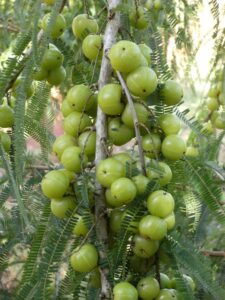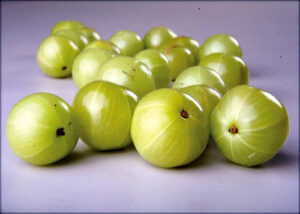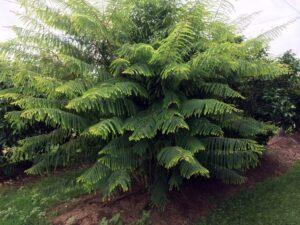
One fine Phyllanthus
By Caleb Roberts
Botanical name: Phyllanthus embilica
Common name(s): Amla, Indian gooseberry
Family: Phyllanthaceae
Origin or native range: There is a saying about some medicines, that a strong taste means they must be doing something right! That certainly rings true for amla, otherwise known as the Indian gooseberry. Hailed as a miracle tree in the East Asian region, the amla is said to pack one of the biggest Vitamin C punches you can find in a fruit. It has served its time as a traditional medicine through its native range in Myanmar, Thailand, Cambodia, Laos, Vietnam, Malaysia, Indonesia and India.
Description: Amla trees will easily grow to 10 m if left alone, taller in the right conditions but take pruning quite well. They produce a sparse crown. Through their deciduous season, amla’s branching structure and striated bark feature boldly in the orchard. As they push into spring, we see dense growth of new pinnate leaflets forming along all branches, tipped with a red flush so vivid that each compound leaf is reminiscent of a lorikeet feather. The flowers are an inconspicuous green/yellow but prolific in number. Forming along every growing stem, and when pollinated by a partnering tree, they produce green berry-like fruit that can hang for months as out of season Christmas baubles. The fruit ranges from 5g in wild stands to 50g each under cultivation. The fruits are ribbed and divide into up to 8 segments when separated from the central stone.

Cultural requirements: P. embilica is an incredibly hardy tree. Known to drop leaves after stress, it bounces back quickly with a new flush of growth after drought, fire, cold or wind. While it is not tolerant of frost, and not partial to salt exposure, it has potential for a wide range of landscaping uses. It does require drainage but is not restricted by soil type as some trees are. It can cope with a broad pH range, between 6 and 8 at the extremes, although there is a cost to plant vigour. Tolerant of partial shade, poor soils and little water, this is an ideal replacement for landscapers looking for a poinciana or jacaranda-like leaf form with a bonus edibility score.
Cultivation: Amla is quite easy to strike by seed. When dry, the segments pop away from the stone. Once the stone dries it has been known to pop open and shoot seeds across the room. Grafting is an option if you have cultivars you would like to multiply, and there has been some success with cuttings. Seed is certainly easiest due to the number obtained per fruit and their willingness to germinate. The trees can take up to 10 years to establish fruiting maturity, so grafting can be used to speed production in that context.
Landscape and horticultural uses: While the potential size may limit the use in our increasingly small backyards, the amla is a perfect street tree to integrate edible and cultural significance into a landscape. Related to the native Phyllanthus virgatus and other common garden weeds, it is tough and hardy, and can produce an interesting textural backdrop to the floral aspects of your garden.

Ecological and cultural notes: I have yet to come across a fruit with insect damage, and ours do not seem bothered by the local bird or possum life. The fruit is often used in chutney or jams with its high pectin content and astringent flavour being balanced by the sugar. Traditionally, it is consumed cooked, brined or as a juice, or the simplest way, with a glass of water. The bitter astringency can be intense for the uninitiated but becomes addictive if you persevere. To me the sensation feels like it overwhelms the bitter receptors and in comparison, everything afterwards, the very air you breathe, is impossibly sweet. Nibbling a fruit, then swishing your mouth with water, is enough to wash away the astringency and enjoy the sweet aftertaste with all its Vitamin C benefits.
Maintenance: Pruning is best done after fruiting or when deciduous, and fertilising should be at the start of the growing season with a regular balanced blend. They are relatively disease free and overall quite a low maintenance addition to the garden.
Caleb Roberts
Daleys Fruit Tree Nursery
W: www.daleysfruit.com.au
